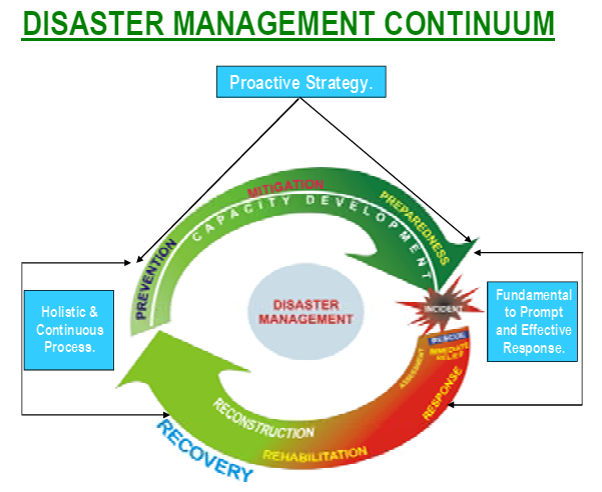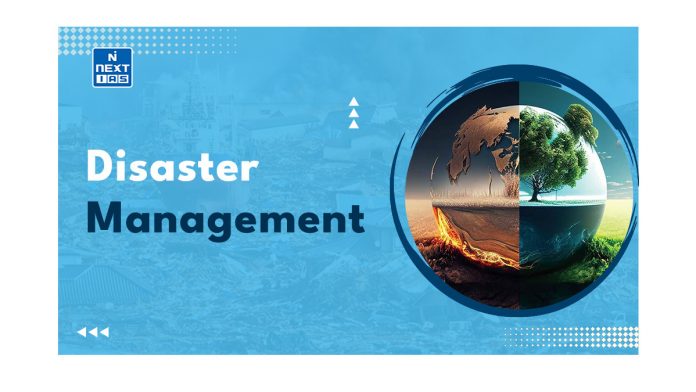Disaster Management encompasses the process of preparing for, responding to, and learning from the consequences of such major failures. It involves dealing with the human, material, economic, and environmental effects caused by a specific disaster. This article aims to provide a comprehensive overview of the Disaster Management and its types, steps & measures.
As per the United Nations, a disaster refers to a significant disruption that hampers the functioning of a community or society. It entails extensive impacts on people, property, the economy, or the environment, surpassing the capacity of the affected community to manage using its own resources.
Types of Disaster
Disasters can take various forms and profoundly disrupt communities, leading to significant consequences for individuals, property, businesses, and the environment. They often test a community’s ability to cope.
Human-caused disasters, resulting from human errors, include incidents like industrial explosions or structural failures. Natural disasters stem from physical occurrences such as earthquakes and droughts. Complex disasters may involve epidemics or armed conflicts.
Disasters can be categorized into different types:
Water-related Disasters
These include floods, hailstorms, cloudbursts, cyclones, heat waves, cold waves, droughts, and hurricanes.
Geological Disasters
This category encompasses landslides, earthquakes, volcanic eruptions, and tornadoes.
Man-made Disasters
These are disasters caused by human activities, such as urban and forest fires, oil spills, and the collapse of large structures.
Biological Disasters
This type involves viral outbreaks, pest invasions, livestock epidemics, and locust plagues.
Industrial Disasters
They encompass chemical and industrial mishaps, mining shaft fires, and oil spills.
Nuclear Disasters
This category includes nuclear core meltdowns and radiation-related burns and illnesses.
Steps in Disaster Management

It is about organizing and managing resources to deal with emergencies. It includes being prepared, responding to the situation, and recovering from it in order to minimize the impact of disasters.
The goal is to prevent hazards from turning into disasters and to reduce the loss of life and property. It involves planning and taking steps before, during, and after a disaster. This includes preparing for disasters, implementing effective response systems, and building resilient communities.
The three main steps:
Pre-disaster Management
This phase focuses on taking action before a disaster occurs. The main purpose is to mitigate human loss. It involves developing information systems, mobilizing resources, assessing risks, issuing warnings through various communication channels, and ensuring the safe transportation of people to secure locations.
Management during Disasters
This phase is crucial and depends on the preparedness done in the pre-disaster phase. It involves taking quick action to help victims in disaster-prone areas, ensuring their safety by relocating them to secure areas, and providing essential needs like food, clothing, and healthcare.
Post-disaster Management
In this phase, the focus is on rebuilding and reconstructing the affected areas. The administration is responsible for providing assistance to affected people, including employment or compensation.
Several Agencies are Involved in Disaster Management in India
- National Disaster Management Authority (NDMA): It is the apex body for disaster management in India, led by the Prime Minister. It supervises and controls the National Disaster Response Force (NDRF).
- National Executive Committee (NEC): It consists of high-profile ministers from the Indian government. The NEC is responsible for implementing the National Plan for Disaster Management as per the National Policy on Disaster Management.
- State Disaster Management Authority (SDMA): Each state has its own SDMA, headed by the Chief Minister. The SDMA works with a State Executive Committee (SEC) to assist in disaster management at the state level.
- District Disaster Management Authority (DDMA): The DDMA is led by the District Collector or equivalent authority and includes elected representatives from the local government. Its role is to ensure that guidelines from the NDMA and SDMA are followed at the district level.
- Local Authorities: Local authorities, such as Panchayati Raj Institutions, Municipalities, and Town Planning Authorities, are responsible for controlling and managing civic services in their respective areas.
Measures to Prevent and Mitigate Disasters
Prevention and mitigation of disasters is an important part of the process of management of disasters. Some of the measures are:
- Critical Infrastructure Safety: Regular checks should be conducted on critical infrastructure such as roads, dams, bridges, and power stations to ensure they meet safety standards and are fortified if necessary.
- Environmentally Sustainable Development: Environmental considerations and developmental efforts should go hand in hand to ensure sustainability.
- Climate Change Adaptation: The challenges posed by climate change, including the increased frequency and intensity of natural disasters, should be addressed through strategies that focus on adaptation and risk reduction.
- Risk Assessment and Vulnerability Mapping: Using tools like Geographic Information System (GIS), mapping and vulnerability analysis should be conducted to identify high-risk areas and develop strategies to address them.
- Urban Planning and Development: Preventing unplanned urbanization and focusing on maintaining natural drainage systems can help reduce the impact of disasters in urban areas.
By implementing these measures, India can better prepare for and mitigate the effects of disasters, making communities safer and more resilient.
Conclusion
Disaster management occupies an important place in India’s policy framework as it is the poor and the underprivileged who are worst affected on account of calamities/disasters.
Disasters retard socio-economic development, further, impoverish the impoverished and lead to diversion of scarce resources from development to rehabilitation and reconstruction. Due to all these factors India has invested resources in mitigation and adaptation resources.
FAQs
What is the aim of Disaster Management?
The aim of disaster management is to reduce the impact of disasters and minimize the loss of life, property, and infrastructure. It focuses on preparedness, response, recovery, and mitigation to enhance the resilience of communities and ensure effective coordination among various stakeholders during emergencies.
How is Disaster Management done in India?
In India, the management of disasters is carried out through a multi-tiered approach. The National Disaster Management Authority (NDMA) formulates policies and guidelines at the national level. State-level and district-level disaster management authorities implement these policies and coordinate disaster response efforts.
They conduct risk assessments, develop disaster management plans, conduct awareness campaigns, establish early warning systems, and coordinate rescue and relief operations during disasters.
What are the different types of Disaster Management in India?
The different types of disaster management in India encompass both natural and man-made disasters. Natural disasters include floods, cyclones, earthquakes, droughts, landslides, and avalanches. Man-made disasters encompass industrial accidents, chemical spills, nuclear incidents, terrorist attacks, and other emergencies arising from human activities.
What type of Disaster is most important in India?
While all types of disasters are significant in India, natural disasters like floods, cyclones, and earthquakes pose substantial challenges due to the country’s geography, population density, and climate variability.
These disasters can cause significant loss of life, displacement of people, damage to infrastructure, and disruption to the economy. Efforts to manage and mitigate these natural disasters are crucial to protecting lives and ensuring the long-term resilience of communities in India.






